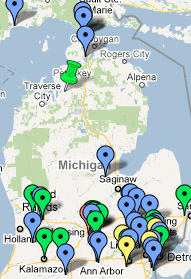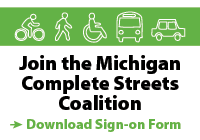You are currently browsing the monthly archive for May 2011.
We are pleased to report that the much anticipated Complete Streets Advisory Council met for the first time on April 27. The Council elected Suzanne Schulz (Michigan Municipal League/Grand Rapids DDA) as Chair, John Niemela (County Road Association of Michigan) as Vice Chair and Andrea Brown (Michigan Association of Planning) as Secretary.
In addition to electing officers, the Council made decisions on how meetings will be conducted and had a lively conversation about potential presentations and topics of discussions for future meetings. The Council will meet quarterly, with the next meeting scheduled for sometime in July. Below you will find a DRAFT copy of detailed meeting minutes.
Over the last four years, New York City has seen a transportation renaissance on its streets, striking a better balance by providing more space for walking, biking, and transit.
As with any departure from the status quo, it can take a while for everyone to grow accustomed to the changes. So Streetfilms decided to look at three of NYC’s most recent re-designs — Columbus Avenue, First and Second Avenues, and Prospect Park West — and show how pedestrians, cyclists, and drivers benefit from safer, calmer streets. We talked to transportation engineers with decades of experience, elected leaders, community board members, people on the street, and business owners to get their take on the new configurations.
Michigan will get nearly $200 million in federal funding to make high-speed rail a reality — and to help build a new bus and train station in Ann Arbor, the U.S. Transportation Department announced this morning.
The bulk of the funds — $196.5 million — is to help retrofit a 135-mile section of the Kalamazoo to Dearborn track for high-speed rail service. In total, this will eventually allow trains to travel 110 miles an hour on 235 miles between Chicago and Detroit, the government said.
The Obama administration has now invested $11 billion in rail service, the government said.
“High-speed rail is coming to America. There is no going back,” Transportation Secretary Ray LaHood told reporters on a conference call. The administration wants to get Americans “on trains, off of congested highways, out of their cars — particularly when gas prices are higher.”
Ahead of his speech in Detroit, he touted “the integral part that Detroit to Chicago plays in our Midwest high-speed rail plan. … Detroit to Chicago is a critical link.”
By Scott T. Clein, P.E., LEED AP
Reposted with permission from the Michigan Municipal League’s May/June issue of The Review magazine
Pedestrian-friendly … walkable … You’ve most likely heard, and used, these terms when describing the future vision of your community. You’ve also likely heard about Complete Streets and assumed it was the same thing.
Technically you’re right…and wrong. While Complete Streets initiatives do improve the walkability of roadways, the concept includes so much more. Before your community takes a dive into the Complete Streets waters, you need to understand whether or not you’ll need a life vest.
In 2010, Michigan joined a growing list of states that enacted legislation related to Complete Streets. Two bills passed that added the phrase to the legislative vernacular and requires the Michigan Department of Transportation to create a Complete Streets policy that serves as a model for communities.
But what is the concept really all about? Below are common definitions that should be considered during Complete Streets planning and discussions.
COMPLETE STREETS is a movement that designs and operates roadway corridors promoting safe access for all users. Roadways, therefore, should accommodate vehicles, transit, bicyclists, and pedestrians of all ages and abilities.
UNIVERSAL ACCESSIBILITY emerged as an offshoot of barrier-free design. It’s the idea that good design must take into account the age and ability of all users from the beginning, even if it means exceeding minimum standards to allow for a better use of space.
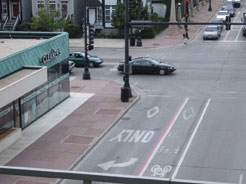 GREEN STREETS encourages sustainability in the design and construction of roadways by using the latest best management practices, such as rain gardens for improving stormwater quality.
GREEN STREETS encourages sustainability in the design and construction of roadways by using the latest best management practices, such as rain gardens for improving stormwater quality.
LIVING STREETS states pedestrians must be properly included in transportation designs. It goes beyond simply adding sidewalks to include active use of the corridor, such as outdoor dining and sales, and neighborhood festivals.
With a clearer understanding of Complete Streets improvements, here are five common myths that may get in the way of planning and implementation.
Myth 1: It’s expensive.
Designs in line with Complete Streets philosophies don’t have to cost a lot, especially when included in annual capital improvement projects. Most communities have existing funding for road maintenance and related upgrades. When resurfacing a roadway, for example, implement bike lanes for little to no added cost.
This piece-by-piece approach may seem out of place when attempting to promote connectivity, but it mimics road maintenance approaches and allows the largest benefits from shrinking budgets.
Myth 2: On-street bike lanes are unsafe.
On the contrary, studies show that on-street bike lanes, when properly marked and signed, are safer for bicyclists and pedestrians than sidewalks.
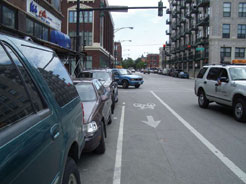 The Transportation Research Board published a study by William Moritz at the University of Washington referencing the Relative Danger Index, which measures bicycle-accident frequency to distance traveled. A higher number represents a greater danger. Sidewalks have an RDI of 5.30 while streets with dedicated bike lanes have an RDI of 0.50.
The Transportation Research Board published a study by William Moritz at the University of Washington referencing the Relative Danger Index, which measures bicycle-accident frequency to distance traveled. A higher number represents a greater danger. Sidewalks have an RDI of 5.30 while streets with dedicated bike lanes have an RDI of 0.50.
Clearly, it’s a misperception that bicyclists are at greater risk on roadway bike lanes. This on-street myth is also perpetuated by the notions that drivers won’t change their driving habits in the presence of a bicyclist and that roadways are only built for vehicles.
Myth 3: It’s only for urban communities.
Urban areas will undoubtedly benefit the most from Complete Streets improvements because of dense pedestrian activity. However, let’s imagine a rural suburban community that has, during the last 30 years, shifted from primarily agricultural land uses to single-family residential developments.
Typically, these developments are islands surrounded by farmland with intermittent access to an open-shoulder country road. They are not truly connected with other neighborhoods and do not allow residents to safely walk or bicycle outside of their subdivision.
Now imagine the same two-lane country road with a paved bike lane along the shoulder. Then add a large shared-use pathway beside the right-of-way line for pedestrians and less-accomplished bicyclists. The result is safely linked subdivisions and a community that is making a dynamic statement about its values.
Myth 4: It negatively impacts traffic flow.
Well…yes, it might. Accommodations for pedestrians and bicyclists may increase driver delay or reduce vehicle speeds. But this is not always a bad thing.
Pedestrian spaces and dedicated bike lanes can create an inviting atmosphere. In addition to promoting a healthier lifestyle, this can help foster the spirit that cool communities seem to have. This so-called “it” factor entices people to live in a neighborhood or city center and directly translates into positive community economic development and financial sustainability.
While there can be repercussions, such as altered traffic patterns that negatively impact surrounding streets, transportation engineers must look at their network holistically and reconsider pavement geometry to encourage safe driving.
Myth 5: “We ARE a walkable community, so this won’t change our plans.”
Some communities have embraced the Complete Streets concept. Still, disagreements between planning and engineering staffs continue largely because of these myths. Simply being walkable does not make a Complete Street. What about ADA compliance and other street amenities? Significant opportunities spring from combining the power of the planning, engineering, and economic development areas of local government.
Consider an engineering department that actively promotes the construction of smaller roadways to incorporate bike lanes, wide sidewalks, and universal design principles. What if the planning department aligns these improvements with zoning ordinances to encourage mixed-use developments with outdoor dining and pedestrian-scale amenities? Now, the economic development director has added firepower to actively recruit businesses and developments. Uniting these groups can unleash the powerful potential to positively impact a community.
This last point is the overarching benefit that must be understood about Complete Streets. When properly infused into a community, a Complete Streets mentality can help unite economic development, land planning, and transportation engineering for bettering the overall quality of life. All community leaders would benefit from understanding the definitions and implications, but also keeping in mind the myths discussed. With the proper perspective and conviction, Complete Streets can make every Michigan community a better place to live.
Giffels-Webster
Giffels-Webster Engineers, Inc. is a civil engineering, surveying, planning, and landscape architecture firm with a 55-year history of serving municipalities and governmental agencies throughout Michigan.
For more on Giffels-Webster, visit www.giffelswebster.com
Scott T. Clein, P.E., LEED AP is an associate at Giffels-Webster.
You may reach him at 313-962-4442 or [email protected].
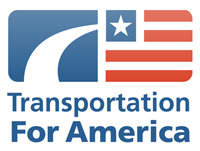 “Safe and Complete Complete Streets Act” officially introduced by Representatives Matsui and LaTourette.
“Safe and Complete Complete Streets Act” officially introduced by Representatives Matsui and LaTourette.
Congresswoman Matsui (D-CA) and Congressman LaTourette (R-OH) officially introduced the “Safe and Complete Streets Act of 2011” (HR 1780) in the House of Representatives this week. This bill would require streets built with federal funding to incorporate Complete Streets design to ensure the safety of all users. Please consider signing your organization on to a letter to your representative asking them to co-sponsor this bill.
Congressman DeFazio introduces “Providing Gas Price Relief Through Public Transportation Act of 2011.”
Congressman DeFazio (D-OR) released a new bill this week that would provide support for transit agencies in response to the twin pressures of tightening state budgets and increasing ridership due to high gas prices. This bill would provide $1.7 billion in capital and operating assistance for transit agencies to help them roll back fare increase fares and restore cut services. Here is a summary of DeFazio’s bill as well as a letter of support that Transportation for America has sent in support of the bill.
“The Older Driver and Pedestrian Safety and Roadway Enhancement Act” officially introduced.
The Older Driver and Pedestrian Safety and Roadway Enhancement Act, HR 1776 was introduced on May 5th by Congressman Jason Altmire (D-PA). The bill invests $500 million annually for low cost roadway safety infrastructure improvements and safety upgrades including updating roadway signs and pavement markings to accommodate the needs of an increasingly older population in addition to giving older drivers a louder voice at the US DOT. The Coalition for Older Roadway User Safety (CORUS), of which T4 is a member, has issued a press release in support of the bill.
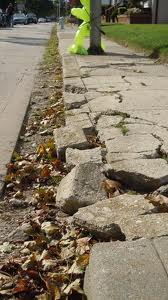 On April 22, the Michigan Court of Appeals ruled that curbs are part of the highway. This is important to the Michigan complete streets movement as it means local governments can no longer claim governmental immunity when someone is injured on a curb.
On April 22, the Michigan Court of Appeals ruled that curbs are part of the highway. This is important to the Michigan complete streets movement as it means local governments can no longer claim governmental immunity when someone is injured on a curb.
In Benton Harbor, Jeanette Sharp was injured when she fell from a crumbling curb. Sharp sued the City of Benton Harbor, on the ground that it had breached a statutory duty to maintain the curb that caused her fall. Benton Harbor moved for summary disposition on the basis of governmental immunity.
The Court of Appeals, however, upholding the Berrien Circuit Court (Sharp v. City of Benton Harbor, COA docket No. 292389), said governmental immunity did not apply.
“Curbs routinely serve as the frames for travel on public roads, and in this sense are integral components of a road,” said Judge Douglas Shapiro, Judge E. Thomas Fitzgerald and Judge Stephen Borrello in the published per curiam opinion.
The court found that the things specifically excluded from the definition of highway in the statute all have one thing in common: they “do not contribute to or assist the public’s ability to travel.” Curbs, the court found, do contribute to travel and so are included within the highway exception to governmental immunity.
 June 6-7, 2011
June 6-7, 2011
The Lansing Center, Lansing, MI
Presented by the Michigan Department of Community Health
The fifth Designing Healthy Livable Communities Conference will feature national and Michigan experts to address how the Power of Partnerships can enhance the collaborative efforts of communities and policy makers to create and maintain healthy Michigan communities.
On the afternoon of June 6th, there will be three pre-conference trainings: Community Visioning, Complete Streets and Food Policy Councils.
On June 7th, two nationally renowned keynote speakers will present: Majora Carter, Eco-Entrepreneur and President of The Majora Carter Group will open the conference with the keynote presentation, “You Don’t Have to Move Out of Your Neighborhood to Live in a Better One.” Tyler Norris, a long time social entrepreneur whose passion is improving the health of people and the sustained vitality of built and natural environments, will provide the second keynote. A choice of six workshops and two concurrent plenary sessions will also be featured.
To register, go to: https://www.regonline.com/2011dhlcconference
For additional information on sponsorship and exhibits, contact the Conference Coordinator, Diane Drago at [email protected] or 517-663-5147.
 The Oakland Township Board of Trustees voted to pass a resolution supporting the Michigan Complete Streets program [on April 12], which helps “ensure that engineers and planners design roadways to accommodate all users, not just motorists,” according to the coalition’s website [that’s us!].
The Oakland Township Board of Trustees voted to pass a resolution supporting the Michigan Complete Streets program [on April 12], which helps “ensure that engineers and planners design roadways to accommodate all users, not just motorists,” according to the coalition’s website [that’s us!].
“In many cases, this means curb ramps, audible or tactile signals for blind pedestrians, longer crossing times, smooth sidewalks and bike paths that are free of obstacles and transit stops that can be easily boarded,” the website says.
Read the rest of this article by Jen Anesi in the Oakland Township Patch
See additional coverage on M-Bike and Romeo Observer
Several Michigan cities have transit funding measures on the ballot next week:
- Voters in Grand Rapids, East Grand Rapids, Wyoming, Kentwood, Grandville and Walker will be asked to expand bus service for the region and add high speed bus transit. It will fund enhanced service on every route and allow the system to keep up with rising demand - ridership on The Rapid has more than doubled in the last ten years. Learn more at RapidYes.org. Also check out this great video about Grand Rapids transit, past and future!
- Voters in Benzie County will be asked May 3 to renew and restore operating funds for the Benzie Transportation Authority with a 0.5 mill. Learn more at Benzie Bus Yes!
- Voters in Grand Haven will be asked to support a five-year 0.95 mill property tax increase to support expansion of Harbor Transit, as well as funding for the repair and construction of roads, bridges and other infrastructure.
- A 0.4 mill renewal is also on the ballot in Holland Township for the Macatawa Area Express Bus.
Many other cities will also be voting on measures to fund vital local services. So check your ballot and remember to go VOTE May 3!



